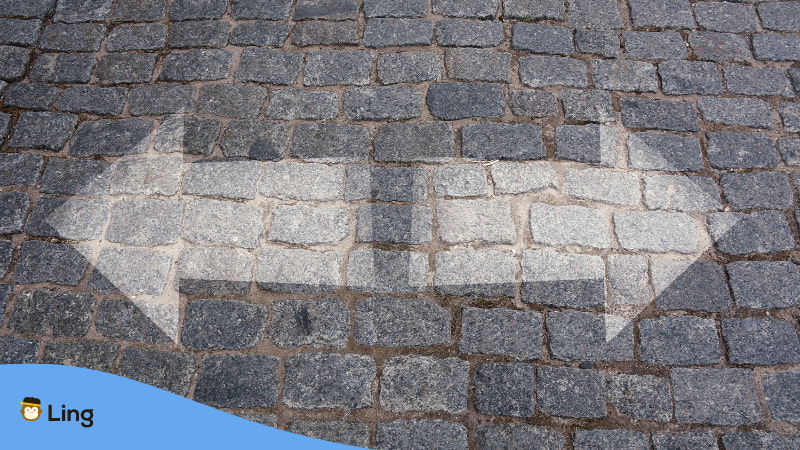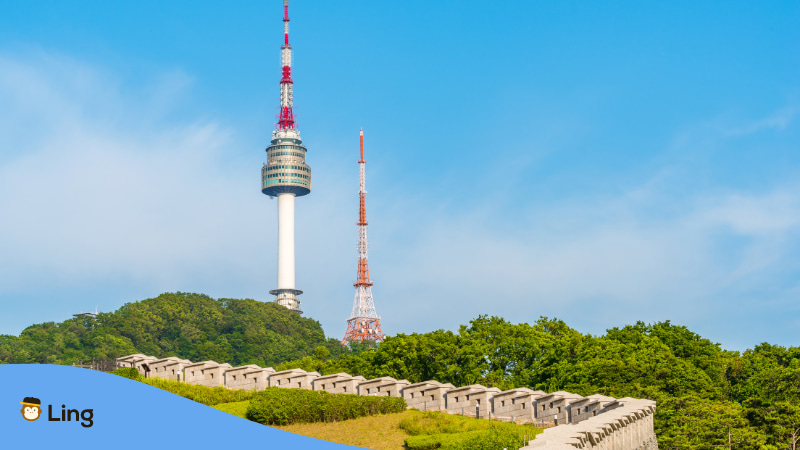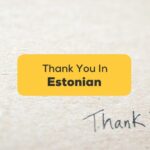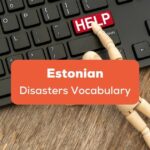Today, Google Maps and GPS apps have changed the game for finding directions. But, learning about 방향 (Banghyang) directions in Korean is still important.
Wandering around the beautiful country of South Korea is a great experience. They have advanced transportation systems and organized traffic rules. But, even if you can travel around the country by just using their transportations such as bus, subway, and taxi, there is still a possibility of getting lost along the way. This is where learning about directions in Korean will come in handy.
So, brace yourself for a fun and free lesson about directions in Korean. If you also want to practice more, you can check Ling App.

What’s The Korean Word For Direction?
방향 (Banghyang)
The first vocabulary that you need to learn about Directions in Korean is, of course, the word “direction.” Koreans use the word 방향 (Banghyang) to say directions in Korean language.
How To Ask And Give Directions In Korean Language
Did you know that you don’t have to worry about learning the right tones when asking and giving directions in Korean language? This is because Korean is not a tonal language, but, there is still a natural rhythm for the pronunciation of the words and phrases. You should also learn that you have to be polite, especially to elders and strangers, when you are talking. This is because Koreans have their politeness level, which they use when talking to people.
There are lots of ways to ask and give directions in Korean. It can be with the use of navigation words and phrases, cardinal directions, landmarks, and addresses. This will be further discussed below as we unfold the ways of giving and asking directions in Korean.
In short, if you want to learn how to ask and give directions in Korean, learn the words and the right way to say them. If you’re a foreigner, it is always better to keep it formal and polite to avoid misunderstandings with the locals.
Ways On Giving And Asking Directions In Korean
If it is your first time, directions in Korea are really confusing. Not just the word or phrase to use but also the fact that you are approaching someone who’s a total stranger to you. But, luckily, there are locals, taxi drivers, and even security guards that are willing to help you out.
So, here are the different ways to ask and give directions in Korean. If you’re a total beginner, do not worry about understanding the Korean words in Hangul because Korean romanization and English translation are available for each word.
1. Cardinal Directions
The first set of words that you’ll have to take note of about directions in Korean is the Cardinal Directions. I know compass and map are not really a trend nowadays because we already have Google Maps on our smartphones but it is still important to know about the Cardinal directions. The four cardinal directions are the four main compass directions: north, east, south, and west, which are frequently abbreviated as N, E, S, and W. Here are the Cardinal directions in Korean:
| Hangul (Korean) | Romanization | English Tanslation |
| 북(쪽) | buk(jjok) | North |
| 남(쪽) | nam(jjok) | South |
| 동(쪽) | dong(jjok) | East |
| 서(쪽) | seo(jjok) | West |

2. Road Opposites
Another most common way to give and ask directions in Korean is to use the road opposites. This is really helpful especially if you’re driving or riding a car. It is also helpful if you are walking on the street and you suddenly get lost. So, learn these road opposites and save them to your Korean vocabulary:
| English Translation | Hangul (Korean) | Romanization |
| front | 앞 | ap |
| back | 뒤 | dwi |
| right | 우회전 | uhoejeon |
| left | 좌회전 | jwahoejeon |
| on the left | 왼쪽에 | oenjjoge |
| on the right | 오른쪽에 | oreunjjoge |
| turn left | 좌회전하다 | jwahoejeonhada |
| turn right | 우회전하다 | uhoejeonhada |
| straight ahead | 정면 | jeongmyeon |
| straight down | 쭉 따라 내려 | jjuk ttara naeryeo |
| far | 멀다 | meolda |
| close by | 가깝다 | gakkapda |
| in front of | 앞에 | ape |
| behind | 뒤에 | dwie |
| right behind | 바로 뒤에 | baro dwie |
| right in front | 바로 앞에 | baro ape |
| between | 사이에 | saie |
3. Landmarks
Identifying landmarks is definitely one of the most effective ways to locate a place. Landmarks will allow the person to see how far they’ve come. They’ll also let you know if the person is still on the path you recommended. Finally, landmarks will bring attention to each portion of the broader route they’re attempting to navigate. So, here are the most common landmarks that people usually use in giving and asking directions:
공항 (Gonghang) – Airport
Asking for directions to the airport is common among tourists. Because the airport is often surrounded by hotels and other go-to establishments for tourists, it is great to use it as a landmark. Here are some airports in South Korea:
- 인천국제공항역 incheongukjegonghangyeok – Incheon International Airport Station
- 김포공항역 gimpogonghangyeok – Gimpo Airport Station
- 양양국제공항 yang-yang-gugjegonghang Yangyang International Airport
- 제주국제공항 jejugugjegonghang Jeju International Airport
- 김해국제공항 gimhaegugjegonghang – Gimhae International Airport
전철역 (Jeoncheollyeok) – Subway Station
South Korea has amazing subway stations, and they are everywhere. So, using the nearest subway station as a landmark is a big brain. If you have already stepped inside a subway or train station, you can easily travel to different places in South Korea. Learn the following stations in the Korean language because this might help you in your travel experience:
| English Translation | Hangul (Korean) | Romanization |
| Gangnam station | 강남역 | gangnamyeok |
| Daejeon Station | 대전역 | daejeonyeok |
| Dongdaegu Station | 동대구역 | dongdaeguyeok |
| Busan station | 부산역 | busanyeok |
| Seoul station | 서울역 | seouryeok |
| Yongsan Station | 용산역 | yongsanyeok |
| Ulsan Station | 울산역 | ulsanyeok |
| Jeonju Station | 전주역 | jeonjuyeok |
| Jeongdongjin Station | 정동진역 | jeongdongjinyeok |
| Jinbu Station | 진부역 | jinbuyeok |
| Chuncheon Station | 춘천역 | chuncheonyeok |
호텔 (Hotel) – Hotel
South Korea is also full of hotels ranging from luxurious down to simple ones. Because these hotels are mostly located on the main roads and big cities, it is often used as a landmark in giving directions. Check this list of hotels in Korea:
| Hotel | Hangul (Korean) | Romanization |
| Landing Jeju Shinhwa World Hotels & Resorts | 랜딩관 제주신화월드 호텔앤리조트 | laending-gwan jejusinhwawoldeu hotel-aenlijoteu |
| Nine Tree Premier Hotel Myeongdong II | 나인트리 프리미어 호텔 명동 II | nainteuli peulimieo hotel myeongdong II |
| Shilla Stay Haeundae | 신라스테이 해운대 | sinlaseutei haeundae |
| Tmark Grand Hotel Myeongdong | 티마크 그랜드 호텔 명동 | imakeu geulaendeu hotel myeongdong |
| Paradise Hotel Busan | 파라다이스 호텔 부산 | paladaiseu hotel busan |
은행 (Eunhaeng) – Bank
Banks are also a good idea for landmarks too. Since there’s a lot of people who are having a transaction with a bank every day, bank owners place their bank’s inaccessible areas. These are the leading banks that you can find in South Korea as you visit their country.
| Bank | Hangul (Korean) | Romanization |
| Citibank Korea | 한국씨티은행 | hangugssitieunhaeng |
| KEB Hana Bank | 하나은행(주) | hana-eunhaeng(ju) |
| KB Kookmin Bank | 국민은행 | gugmin-eunhaeng |
| Standard Chartered Korea | SC제일은행 | SCjeil-eunhaeng |
| Shinhan Bank | 주식회사 신한은행 | Jusik Hoesa Sinhan Eunhaeng |
| Woori Bank | 우리은행 | Uri Eunhaeng |
| Busan Bank | 부산은행 | busaneunhaeng |
| Kyongnam Bank | BNK경남은행 | BNKgyeongnameunhaeng |
| Kwangju Bank | 광주은행 | gwangjueunhaeng |
| Jeonbuk Bank | 전북은행 | jeonbugeunhaeng |

공원 (Gongwon) – Park
Parks are one of the tourist attractions most visited by tourists so most of the locals and drivers know them. Take note of these parks in South Korea. You might use this in the future.
| Park | Hangul (Korean) | Romanization |
| Anyang Art Park | 안양예술공원 | anyang yesulgongwon |
| Dadohaehaesang | 다도해해상국립공원 | dadohaehaesang-guglibgong-won |
| Seoraksan | 설악산 국립공원 | seol-agsan guglibgong-won |
| Bukhansan | 북한산국립공원 | bughansanguglibgong-won |
| Gyeongju National Park | 경주국립공원 | gyeongjuguglibgong-won |
병원 (Byeongwon) – Hospital
Next are the hospitals. Emergencies may happen everywhere that’s why hospitals are located in places that are accessible to people and most people know where the hospitals are. This makes them a good landmark for asking and giving directions in Korean. Below are some of the hospitals in South Korea:
| Hospital | Hangul (Korean) | Romanization |
| Asan Medical Center | 서울아산병원 | eourasanbyeongwon |
| Samsung Medical Center | 삼성의료원 | samseonguiryowon |
| Seoul National University Hospital | 서울대학교병원 | seouldaehakgyobyeongwon |
| Severance Hospital, Yonsei University | 세브란스 병원 | sebeuranseu byeongwon |
| The Catholic University Of Korea, Seoul St. Mary’s Hospital | 가톨릭대학교 서울성모병원 | gatollikdaehakgyo seoulseongmobyeongwon |
| Ajou University Hospital | 아주대학교 | ajudaehakgyo |
쇼핑몰 (Syopingmol) – Shopping mall
It’s impossible to visit South Korea without going to shopping malls. It is definitely one of the highlights of your trip since you also see them in K-dramas. Since South Korea has a lot of shopping malls, they are good as landmarks. Check out these shopping malls in South Korea:
| Shopping Mall | Hangul (Korean) | Romanization |
| Lotte Department Store | 롯데백화점 및 롯데홈쇼핑 | rosdebaekhwajeom mit rosdehomsyoping |
| Starfield COEX Mall | 코엑스몰 | koekseumol |
| Mecenatpolis Mall | 메세나폴리스몰 | mesenapolliseumol |
| Times Square Mall | 타임스퀘어 | taimseukweeo |
| Doota Mall | 두산타워 | dusantawo |
지하상가 (Jihasangga) – Underground Shopping Mall
For OG K-pop and K-drama fans, underground shopping malls are heaven. You can shop for goods and merch for very cheap prices. This is the reason why they’re famous to people not just locals but also the foreigners whih=ch makes it a good landmark.
| Underground Shopping Mall | Hangul (Korean) | Romanization |
| Goto Mall and Famille Station | 파미에스테이션 | pamieseuteisyeon |
| Yeongdeungpo Underground Mall and Times Square | 영등포 지하상가 타임스퀘어 | yeongdeungpo jihasang-ga taimseukweeo |
| Gangnam Underground Shopping Center | 강남역 지하상가 | gangnamyeok jihasangga |
| Jamsil Underground Shopping Center | 잠실지하상가 | jamsiljihasang-ga |

Other Landmarks In Korean
| English Translation | Hangul (Korean) | Romanization |
| Convenience Store | –편의점 | Pyeonuijeom |
| Pedestrian bridge | 육교 | Yukgyo |
| bus stop | 버스정류장 | beoseujeongnyujang |
| traffic light | 신호등 | sinhodeung |
| zoo | 동물원 | dongmurwon |
| beach | 해변 | haebyeon |
| restaurant | 식당 | sikdang |
| market | 시장 | sijang |
| museum | 박물관 | bangmulgwan |
| library | 도서관 | doseogwan |
| coffee shop | 커피숍 | keopisyop |
| supermarket | 슈퍼마켓 | syupeomaket |
| gas station | 주유소 | juyuso |
| school | –학교 | hakgyo |
| university | –대학교 | daehakgyo |
4. Korean Address
While watching K-dramas, have you noticed that there are only a few scenes where they show their addresses? It’s because Korean roads and streets did not even have names until a few years ago. This is really confusing for taxi drivers. In fact, taxi drivers are frequently unfamiliar with street names, and satellite navigation systems may direct you to the incorrect section of the street.
But, if you are really want to use your address or give it to somebody, you have to remember that Korean addresses have a pattern that is quite different from what you are used to in your country. In South Korea, they use the pattern city-district-major road – minor road-building.

Korean Words And Phrases Related To Directions
Now that you have learned the different ways to tell directions in Korean, let us now learn more words and phrases related to the topic. If you want to level up this lesson, you can visit Ling App.
| English Translation | Hangul (Korean) | Romanization |
| to | 로 | ro |
| from | 부터 | buteo |
| road | 도로 | do-ro |
| intersection | 교차로 | gyocha-ro |
| away from | ~에서 떨어진 | ~eseo tteoreojin |
| to cross | 건너다 | geonneoda |
| to stop | 정지하다 | jeongjihada |
| Go straight. | 쭉 가다 | jjuk gada |
| Excuse me. | 저기 죄송한데요. 실례합니다. 죄송한데요. | Jeogi joesonghandeyo. Sillyehamnida. Joesonghandeyo. |
| Where is [location]? | 장소]은/는 어디에 있습니까? 장소]은/는 어디에 있나요? | Jangso]eun/neun eodie itseumnikka? (formal – business level) jangso]eun/neun eodie innayo? (formal – friendly) |
| Is there [location] near here? | 이 근처에 [장소]있나요? | I geuncheoe [jangso] innayo? |
| Where is the restroom? | 화장실은 어디에 있나요? | Hwajangsireun eodie innayo? |
| Is there a bus from the airport to the city? | 공항에서 도시로 가는 버스가 있나요? | Gonghangeseo dosiro ganeun beoseuga innayo? |
| Is this the right bus for the airport? | 공항으로 가는 버스 맞아요? | Gonghangeuro ganeun beoseu majayo? |
| Where is the train station? | 기차역이 어디예요? | Gichayeogi eodiyeyo? |
| I’d like to go to Seoul Station. | 서울역에 가고 싶은데요. | Seoullyeoge gago sipeundeyo. |
| Please take me to Silla Hotel. | 신라호텔로 가주세요. | Sillahotello gajuseyo. |
| Does this stop at Seoul Station? | 이거 서울역에서 서요? | Igeo seoullyeogeseo seoyo? |
| What is the shortest route to this hotel? | 이 호텔로 가는 지름길은 뭐예요? | I hotello ganeun jireumgireun mwoyeyo? |
| How do I go to Isu Yeok from here? | 여기서 이수역까지 가려면 어떻게 가면 되나요? | Yeogiseo isuyeokkkaji garyeomyeon eotteoke gamyeon doenayo? |
| I can’t find the way back to my hotel. | 호텔로 돌아가는 길을 못 찾겠어요. | Hotello doraganeun gireul mot chatgesseoyo. |
| I want to withdraw some money. Where is the bank? | 돈 좀 뽑고 싶은데 은행이 어디에 있지? | Don jom ppopgo sipeunde eunhaengi eodie itji? |
| We should go to either Myeongdong Dongdaemoon or Hongdae? | 동대문? 홍대? 아니면 명동이지 않을까? | Myeongdongiji Dongdaemun or Hongdae animyeon aneulkka? |
Going To South Korea? Learn Korean With The Ling App Now!
Going to Korea without knowing some Korean words is like a soldier without a firearm. South Korea is truly an amazing place aside from being the home of K-pop idols and K-drama actors. So, why not level up your trip by learning Korean with the Ling app now?
Backed by linguistic research, the Ling app has truly developed its features to provide a meaningful but fun language learning experience for learners. With the variety of topics, audio recordings from native speakers, English translations, romanizations, and spaced repetition, you’ll learn Korean in record time. See for yourself by checking it on the App Store or Google Play!
Do not wait for the time to pass without learning a new language. Start learning Korean now!



































































